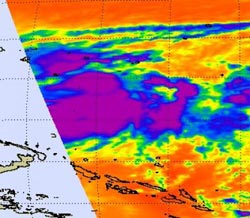NASA sees Tropical Storm Bopha intensifying in Micronesia

This infrared image of the eastern side of Tropical Storm Bopha was captured on Nov. 27 at 0241 UTC by the AIRS instrument that flies aboard NASA's Aqua satellite. The purple areas indicate coldest, highest cloud top temperatures that have the potential for dropping heavy rainfall.<br><br>Credit: NASA JPL/Ed Olsen<br>
The Atmospheric Infrared Sounder (AIRS) instrument that flies aboard NASA's Aqua satellite captured an infrared image of Tropical Storm Bopha on Nov. 27 at 0241 UTC that indicated a lot of power exists in the strengthening tropical storm. The AIRS image captured the eastern half of the tropical storm and showed a large area of very cold, very high cloud tops, where temperatures colder than -63 Fahrenheit (-52 Celsius) have the potential for dropping heavy rainfall.
On Nov. 27, the National Weather Service in Tiyan, Guam noted that “Residents of Satawal in Yap State should closely monitor the progress of Tropical Storm Bopha, as a tropical storm watch could be required Wednesday, Nov. 28.” A tropical storm warning remained in effect for Nukuoro in Pohnpei State and Lukunor in Chuuk State. A tropical storm watch remains in effect for Losap, the Chuuk Lagoon Islands and Puluwat in Chuuk State.
At 1500 UTC (10 a.m. EST/1 a.m. CHST local time) the center of Tropical Storm Bopha was located near latitude 4.7 degrees north and longitude 155.2 degrees east, only 55 miles north-northeast of Nukuoro. Bopha was also about105 miles southeast of Lukunor and 225 miles southeast of Losap. Tropical Storm Bopha was nearly stationary but the National Weather Service expects Bopha to start moving westward.
Bopha's maximum sustained winds have increased to 50 mph and Tropical Storm Bopha is expected to continue intensifying. Tropical storm force winds extend outward up to 45 miles from the center, making the storm almost 100 miles in diameter.
For specific information on effects to individual islands, visit the National Weather Service website: http://www.prh.noaa.gov/data/GUM/HLSPQ1.
Media Contact
More Information:
http://www.nasa.govAll latest news from the category: Earth Sciences
Earth Sciences (also referred to as Geosciences), which deals with basic issues surrounding our planet, plays a vital role in the area of energy and raw materials supply.
Earth Sciences comprises subjects such as geology, geography, geological informatics, paleontology, mineralogy, petrography, crystallography, geophysics, geodesy, glaciology, cartography, photogrammetry, meteorology and seismology, early-warning systems, earthquake research and polar research.
Newest articles

A universal framework for spatial biology
SpatialData is a freely accessible tool to unify and integrate data from different omics technologies accounting for spatial information, which can provide holistic insights into health and disease. Biological processes…

How complex biological processes arise
A $20 million grant from the U.S. National Science Foundation (NSF) will support the establishment and operation of the National Synthesis Center for Emergence in the Molecular and Cellular Sciences (NCEMS) at…

Airborne single-photon lidar system achieves high-resolution 3D imaging
Compact, low-power system opens doors for photon-efficient drone and satellite-based environmental monitoring and mapping. Researchers have developed a compact and lightweight single-photon airborne lidar system that can acquire high-resolution 3D…





















